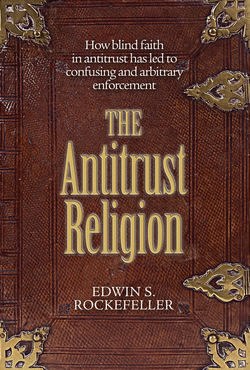Читать книгу The Antitrust Religion - Edwin S. Rockefeller - Страница 8
На сайте Литреса книга снята с продажи.
No Clear Rules—Arbitrary Decisions
ОглавлениеLacking any coherent, ascertainable rules in the written antitrust statutes, judges and other government officials make arbitrary decisions using antitrust doctrines based on a faith not easily overcome by reason, logic, or empirical data. There is no need to explain decisions not made. A contract, a “monopoly,” or a merger permitted requires no explanation. Most corporate mergers reviewed by the government are cleared without question or explanation. Only attacks call for justification. If the decisionmaker wishes to disapprove, the language of antitrust is there to justify the disapproval. Metaphorical labels such as “the market” are used as though they are factual descriptions. Antitrust doctrine containing a prohibition is recited. The disapproval has been rationalized.
The success of Microsoft Corp. came at the expense of some of Microsoft’s competitors—losers in the marketplace who sought government action against a winner. Interest was first aroused at the FTC, where two commissioners favored action, two favored doing nothing, and the fifth declined to participate. The assistant attorney general at the time was an activist new to the job. She took over the matter and persuaded Microsoft to make some changes in its method of doing business. That agreement was presented to a district court for adoption as a consent decree without any findings of fact. The district judge to whom the case was assigned had read some books about computers. On the basis of such reading he rejected the decree as inadequate.14 A reviewing court of appeals said it was the job of the attorney general, not a district judge, to decide the adequacy of such decrees.15 The appeals court sent the matter back to a different district judge.16 That judge later denied a contempt petition, issued a preliminary injunction, and referred the case to a special master,17 a decision reversed by the court of appeals.18 Meanwhile, the Justice Department began an entirely new, somewhat broader, proceeding that resulted in a district court’s issuance of 400 or so “findings of fact”19 and then a memorandum and order, in which the judge confessed an inability to determine what to do because of divergent opinions about the future.20 He concluded that “plaintiffs won the case, and for that reason alone have some entitlement to a remedy of their choice,” including breaking up the defendant.21 That remedy should be adopted, he said, because it was urged by government officials “in conjunction with multiple consultants,” and such officials are expected to act in the public interest, whereas the defendant is not.22 That order was vacated by the court of appeals.23 The court recited prevailing doctrines of market definition and power, which contain assumptions about a future that no one can know but could be applied to the Microsoft case because of the phraseology of the district judge’s findings of “fact.”24 Assisted by some notions about “short term” and “long term” and some fine distinctions between “procompetitive” and “anticompetitive” conduct, the Court labeled Microsoft, like the legendary Standard Oil, a monopolizer and as such prohibited by section 2 of the Sherman Act.25 The Justice Department abandoned any further attempt to break up the company but did insist on several regulatory restrictions to protect complaining competitors.26
